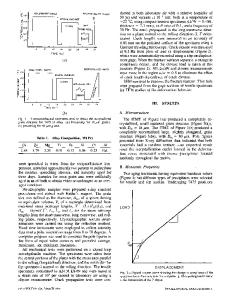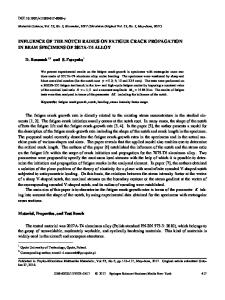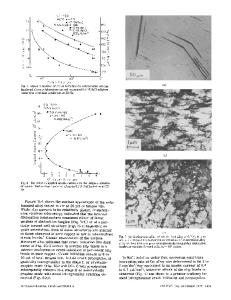The effect of microstructure on the fatigue crack propagation behavior of an Al-Zn-Mg-Cu alloy
- PDF / 2,736,147 Bytes
- 7 Pages / 594 x 774 pts Page_size
- 39 Downloads / 322 Views
fatigue crack propagation behavior of aluminum and titanium alloys also showed experimental evidence which demonstrated improvements in crack propagation resistance with increased tendency for planar slip. H-12 However, it was found in these studies, that such improvement was observed only when the fatigue tests were performed in an inert environment. Laboratory air for example was leading already to an opposite ranking with regard to the fatigue crack propagation resistance between age hardening conditions with a planar as compared to a more homogeneous deformation mode. 11 The purpose o f the present study was to investigate the effect of the slip distribution on the fatigue crack propagation behavior of an AI-Zn-Mg-Cu alloy in an inert environment. Various conditions with different heat treatments were selected in order to obtain a wide spectrum of different slip distributions: microstructures with shearable or nonshearable precipitates of different sizes and volume fractions, but leading to the same yield stress and microstructures with the same volume fraction of shearable precipitates but different particle sizes. With the investigation o f these conditions it was hoped to further the understanding of the influence of slip distribution on the fatigue crack propagation behavior o f age-hardened alloys.
2.
EXPERIMENTAL PROCEDURE
The high purity laboratory aluminum alloy with the basic composition A1-5.9Zn-2.6Mg-l.7Cu (wt pct) was prepared by Alcan Laboratories, Banbury, U. K., where the cast ingots were rolled at 430 ~ to a thickness of 25 ram. The chemical composition of this alloy is shown in Table I. Blanks of these plates were solution heat treated at 450 ~ for 1 h, quenched in ice-water and immediately rolled at room temperature to a final
ISSN 0360-2133/ 81/0911-1613500.75l0 METALLURGICALTRANSACTIONSA 9 1981 AMERICAN SOCIETY FOR METALS AND VOLUME 12A, SEPTEMBER 1981--1613 THE METALLURGICAL SOCIETY OF AIME
Table I. Chemical Composition of the Alumunlum Alloy (WI Pct) Zn
Mg
Cu
Cr
Si
Fe
Mn
Ti
AI
5.93
2.58
1.7
0.002
(0.01
(0.01
0.002
0.017
Balance
thickness of about 12 ram. Tensile specimens, with gage dimensions of 5 mm diam and 25 mm length, and single edge notched (SEN) specimens, with gage dimensions of 2.5 mm thickness, 20 m m width and 50 mm length, were machined so that the stress axis upon testing would be parallel to the rolling direction. The specimens were recrystallized at 450 ~ for 2 h, quenched in ice-water and aged at room temperature or stored at room temperature for two days before aging them at 100 or 160 ~ for various times. The recrystallized material showed an equiaxed grain structure with a grain size of about 100 #m. The starter notch of the SEN specimens was machined by spark erosion cutting after the final aging treatment. Tensile tests were performed at room temperature in air employing an initial strain rate of 6 • 10 -4 s-1. All fatigue crack propagation tests were carried out at room temperature in vacuum ( ~ 10 -4 Pa) on a closed-loop servohydraulic machin
Data Loading...











